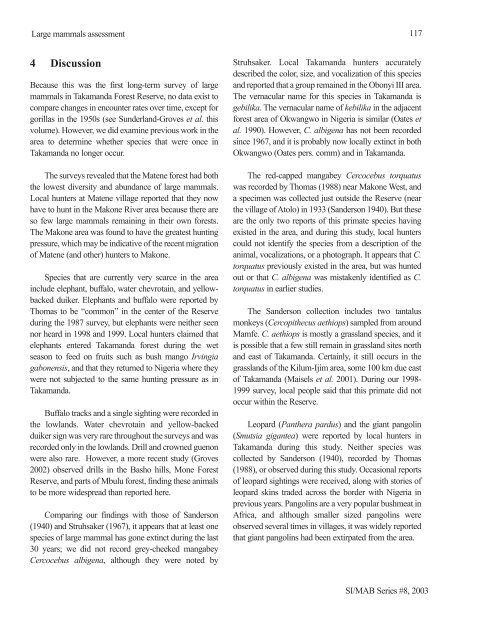Fisheries in the Southern Border Zone of Takamanda - Impact ...
Fisheries in the Southern Border Zone of Takamanda - Impact ...
Fisheries in the Southern Border Zone of Takamanda - Impact ...
Create successful ePaper yourself
Turn your PDF publications into a flip-book with our unique Google optimized e-Paper software.
Large mammals assessment<br />
4 Discussion<br />
Because this was <strong>the</strong> first long-term survey <strong>of</strong> large<br />
mammals <strong>in</strong> <strong>Takamanda</strong> Forest Reserve, no data exist to<br />
compare changes <strong>in</strong> encounter rates over time, except for<br />
gorillas <strong>in</strong> <strong>the</strong> 1950s (see Sunderland-Groves et al. this<br />
volume). However, we did exam<strong>in</strong>e previous work <strong>in</strong> <strong>the</strong><br />
area to determ<strong>in</strong>e whe<strong>the</strong>r species that were once <strong>in</strong><br />
<strong>Takamanda</strong> no longer occur.<br />
The surveys revealed that <strong>the</strong> Matene forest had both<br />
<strong>the</strong> lowest diversity and abundance <strong>of</strong> large mammals.<br />
Local hunters at Matene village reported that <strong>the</strong>y now<br />
have to hunt <strong>in</strong> <strong>the</strong> Makone River area because <strong>the</strong>re are<br />
so few large mammals rema<strong>in</strong><strong>in</strong>g <strong>in</strong> <strong>the</strong>ir own forests.<br />
The Makone area was found to have <strong>the</strong> greatest hunt<strong>in</strong>g<br />
pressure, which may be <strong>in</strong>dicative <strong>of</strong> <strong>the</strong> recent migration<br />
<strong>of</strong> Matene (and o<strong>the</strong>r) hunters to Makone.<br />
Species that are currently very scarce <strong>in</strong> <strong>the</strong> area<br />
<strong>in</strong>clude elephant, buffalo, water chevrota<strong>in</strong>, and yellowbacked<br />
duiker. Elephants and buffalo were reported by<br />
Thomas to be “common” <strong>in</strong> <strong>the</strong> center <strong>of</strong> <strong>the</strong> Reserve<br />
dur<strong>in</strong>g <strong>the</strong> 1987 survey, but elephants were nei<strong>the</strong>r seen<br />
nor heard <strong>in</strong> 1998 and 1999. Local hunters claimed that<br />
elephants entered <strong>Takamanda</strong> forest dur<strong>in</strong>g <strong>the</strong> wet<br />
season to feed on fruits such as bush mango Irv<strong>in</strong>gia<br />
gabonensis, and that <strong>the</strong>y returned to Nigeria where <strong>the</strong>y<br />
were not subjected to <strong>the</strong> same hunt<strong>in</strong>g pressure as <strong>in</strong><br />
<strong>Takamanda</strong>.<br />
Buffalo tracks and a s<strong>in</strong>gle sight<strong>in</strong>g were recorded <strong>in</strong><br />
<strong>the</strong> lowlands. Water chevrota<strong>in</strong> and yellow-backed<br />
duiker sign was very rare throughout <strong>the</strong> surveys and was<br />
recorded only <strong>in</strong> <strong>the</strong> lowlands. Drill and crowned guenon<br />
were also rare. However, a more recent study (Groves<br />
2002) observed drills <strong>in</strong> <strong>the</strong> Basho hills, Mone Forest<br />
Reserve, and parts <strong>of</strong> Mbulu forest, f<strong>in</strong>d<strong>in</strong>g <strong>the</strong>se animals<br />
to be more widespread than reported here.<br />
Compar<strong>in</strong>g our f<strong>in</strong>d<strong>in</strong>gs with those <strong>of</strong> Sanderson<br />
(1940) and Struhsaker (1967), it appears that at least one<br />
species <strong>of</strong> large mammal has gone ext<strong>in</strong>ct dur<strong>in</strong>g <strong>the</strong> last<br />
30 years; we did not record grey-cheeked mangabey<br />
Cercocebus albigena, although <strong>the</strong>y were noted by<br />
117<br />
Struhsaker. Local <strong>Takamanda</strong> hunters accurately<br />
described <strong>the</strong> color, size, and vocalization <strong>of</strong> this species<br />
and reported that a group rema<strong>in</strong>ed <strong>in</strong> <strong>the</strong> Obonyi III area.<br />
The vernacular name for this species <strong>in</strong> <strong>Takamanda</strong> is<br />
gebilika. The vernacular name <strong>of</strong> kebilika <strong>in</strong> <strong>the</strong> adjacent<br />
forest area <strong>of</strong> Okwangwo <strong>in</strong> Nigeria is similar (Oates et<br />
al. 1990). However, C. albigena has not been recorded<br />
s<strong>in</strong>ce 1967, and it is probably now locally ext<strong>in</strong>ct <strong>in</strong> both<br />
Okwangwo (Oates pers. comm) and <strong>in</strong> <strong>Takamanda</strong>.<br />
The red-capped mangabey Cercocebus torquatus<br />
was recorded by Thomas (1988) near Makone West, and<br />
a specimen was collected just outside <strong>the</strong> Reserve (near<br />
<strong>the</strong> village <strong>of</strong> Atolo) <strong>in</strong> 1933 (Sanderson 1940). But <strong>the</strong>se<br />
are <strong>the</strong> only two reports <strong>of</strong> this primate species hav<strong>in</strong>g<br />
existed <strong>in</strong> <strong>the</strong> area, and dur<strong>in</strong>g this study, local hunters<br />
could not identify <strong>the</strong> species from a description <strong>of</strong> <strong>the</strong><br />
animal, vocalizations, or a photograph. It appears that C.<br />
torquatus previously existed <strong>in</strong> <strong>the</strong> area, but was hunted<br />
out or that C. albigena was mistakenly identified as C.<br />
torquatus <strong>in</strong> earlier studies.<br />
The Sanderson collection <strong>in</strong>cludes two tantalus<br />
monkeys (Cercopi<strong>the</strong>cus aethiops) sampled from around<br />
Mamfe. C. aethiops is mostly a grassland species, and it<br />
is possible that a few still rema<strong>in</strong> <strong>in</strong> grassland sites north<br />
and east <strong>of</strong> <strong>Takamanda</strong>. Certa<strong>in</strong>ly, it still occurs <strong>in</strong> <strong>the</strong><br />
grasslands <strong>of</strong> <strong>the</strong> Kilum-Ijim area, some 100 km due east<br />
<strong>of</strong> <strong>Takamanda</strong> (Maisels et al. 2001). Dur<strong>in</strong>g our 1998-<br />
1999 survey, local people said that this primate did not<br />
occur with<strong>in</strong> <strong>the</strong> Reserve.<br />
Leopard (Pan<strong>the</strong>ra pardus) and <strong>the</strong> giant pangol<strong>in</strong><br />
(Smutsia gigantea) were reported by local hunters <strong>in</strong><br />
<strong>Takamanda</strong> dur<strong>in</strong>g this study. Nei<strong>the</strong>r species was<br />
collected by Sanderson (1940), recorded by Thomas<br />
(1988), or observed dur<strong>in</strong>g this study. Occasional reports<br />
<strong>of</strong> leopard sight<strong>in</strong>gs were received, along with stories <strong>of</strong><br />
leopard sk<strong>in</strong>s traded across <strong>the</strong> border with Nigeria <strong>in</strong><br />
previous years. Pangol<strong>in</strong>s are a very popular bushmeat <strong>in</strong><br />
Africa, and although smaller sized pangol<strong>in</strong>s were<br />
observed several times <strong>in</strong> villages, it was widely reported<br />
that giant pangol<strong>in</strong>s had been extirpated from <strong>the</strong> area.<br />
SI/MAB Series #8, 2003

















